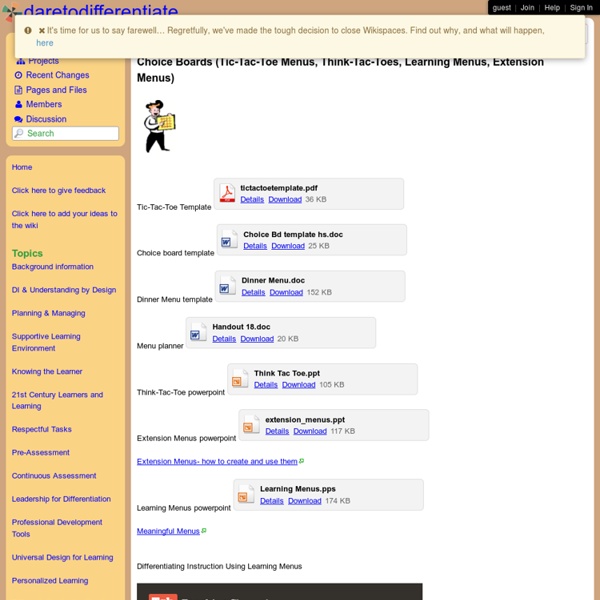



What UDL? Universal Design for Learningis a set of principles for curriculum development that give all individuals equal opportunities to learn. UDL provides a blueprint for creating instructional goals, methods, materials, and assessments that work for everyone--not a single, one-size-fits-all solution but rather flexible approaches that can be customized and adjusted for individual needs. Why is UDL necessary? Individuals bring a huge variety of skills, needs, and interests to learning. Recognition Networks The "what" of learning How we gather facts and categorize what we see, hear, and read. Strategic Networks The "how" of learning Planning and performing tasks. Affective Networks The "why" of learning How learners get engaged and stay motivated. Source: CAST - What is UDL? Learn more about UDL:
Stop The False Generalizations About Personalized Learning In March, Tom Loveless, a fellow at the Brookings Institution, took an outdated swipe at the logic behind moving toward a student-centered learning system. He in essence suggested that because the curriculum wars have been decided more or less empirically, that people bent on disrupting the classroom and the factory-model education system were doing so under faulty assumptions about how students learn. In his piece, he attacked the logic of teaching around multiple intelligences and pointed to some of the research that shows that tailoring learning opportunities to common assumptions around visual, auditory, and other such supposed learning styles are not good ways of teaching different students. Today’s factory-model education system, which was built to standardize the way we teach, falls short in educating successfully each child for the simple reason that just because two children are the same age, it does not mean they learn at the same pace or should follow the same pathway.
The Noon Day Project Welcome to the Noon Day Project The next Noon Day project adventure will start on March 10, 2014. I hope you can join us then. For more information contact Greg Bartus, the project leader. Special greetings to our colleagues at AMTNJ (Association of Math Teachers of New Jersey) who are celebrating their Centennial anniversary this year! Measuring the Circumference of the Earth The Goal of the Noon Day Project is to have students measure the circumference of the earth using a method that was first used by Eratosthenes over 2000 years ago. Students at various sites around the world will measure shadows cast by a meter stick and compare their results. From this data students will be able to calculate the circumference of the earth. The Eratosthenes Experiment Watch as Carl Sagan describes some of the background surrounding Eratosthenes' experiment, which is the basis for this project.
6 Scaffolding Strategies to Use With Your Students What's the opposite of scaffolding a lesson? It would be saying to students something like, "Read this nine-page science article, write a detailed essay on the topic it explores, and turn it in by Wednesday." Yikes -- no safety net, no parachute, no scaffolding -- just left blowing in the wind. Let's start by agreeing that scaffolding a lesson and differentiating instruction are two different things. Simply put, scaffolding is what you do first with kids, then for those students who are still struggling, you may need to differentiate by modifying an assignment and/or making accommodations for a student (for example, choose more accessible text and/or assign an alternative project). Scaffolding and differentiation do have something in common though. So let's get to some scaffolding strategies you may or may not have tried yet, or perhaps you've not used them in sometime and just need a gentle reminder on how awesome and helpful they can be when it comes to student learning: 1. 2. 3. 4. 5.
Digital Library for Earth System Education Student Engagement: Resource Roundup Facebook Edutopia on Facebook Twitter Edutopia on Twitter Google+ Pinterest Edutopia on Pinterest WHAT WORKS IN EDUCATION The George Lucas Educational Foundation Tips and Strategies for Keeping Students Engaged Igniting Student Engagement: A Roadmap for Learning, by John McCarthy (2015) McCarthy discusses key strategies to ensure student engagement including being authentic, introducing units with meaningful launch events, and letting students know what outcomes to expect. Back to Top Engagement Through Projects Integrated Learning: One Project, Several Disciplines, by Edutopia Staff (2015) For any project within a vocational major, High Tech High encourages teachers and students to include relevant content from other subject areas to enhance real-world connections. Engagement Through Technology Engagement Through Social and Emotional Learning Getting (and Keeping) Students Engaged Create experiences so students invest in their learning.